| Columns Retired Columns & Blogs |
Entech Number Cruncher 203.2 & 205.2 D/A converters Measurements
Sidebar 4: Measurements
Footnote 1: A TosLink optical link has a lower bandwidth than an electrical connection, thus inherently introducing jitter that is correlated with the analog signal encoded within the bits. However, an electrical connection has to have the transmitter and receiver resistances and the characteristic impedance of the cable carefully matched if word-clock jitter is to remain low.—John Atkinson
While many of the electrical measurements for the two Entech processors were very similar—both were noninverting, both had an output level around 2.65V RMS, nearly 2.5dB above the CD standard level of 2V—they had very different output impedances. The 203.2's analog output was sourced from a low, not-unusual 590 ohms. The 205.2, however, featured a source impedance of less than 1 ohm, which should render it capable of driving pretty much any load its owner wishes—even the proverbial length of wet string! I assume it has an extra output driver stage, as it drove loads down to 50 ohms at maximum level without apparent distress, though into even lower loads than this it clipped asymmetrically at full level.
The frequency responses of the Entechs were identical. The response shown in fig.1 is for the 205.2; the lower trace is the response with de-emphasis. The output is down by a fraction of a dB at 20kHz, which should not have any audible consequences. There is a 0.15dB level mismatch. The 203.2 was better in this respect.
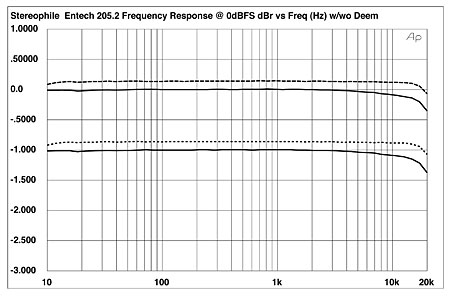
Fig.1 Entech 205.2, frequency response at 0dBFS without de-emphasis (top) and with (bottom). (Right channel dashed, 0.5dB/vertical div.)
Fig.2 shows the channel separation plotted against frequency for both processors. The uniform rise in crosstalk with frequency is due to capacitive coupling between the channels. Interestingly, the 203.2 (lower pair of traces) has about 10dB better channel separation than the 205.2, perhaps due to the latter's extra output stage.
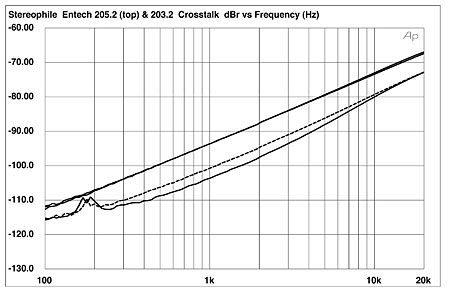
Fig.2 Entech 203.2 (bottom) and 205.2 (top) crosstalk. (10dB/vertical div., R–L dashed.)
Both units featured very low noise floors, which can be seen in the spectrum of the 205.2's output while it decoded a dithered 1kHz tone at –90dBFS (fig.3). (The 203.2's spectrum was almost identical.) Though a spike of energy can be seen at 200Hz, this might well be a spurious noise from the Audio Precision test gear, as it was not always repeatable. Peaks can be seen at the 60Hz power-supply frequency, though these are very low in absolute level, with the right channel 10dB better than the left. The top trace is with the Audio Precision System One outputting 16-bit data; the bottom trace is 20-bit data, showing that the Entechs can indeed handle 20-bit data, and that their inherent resolution is better than 16 bits. The 4-bit increase in word depth gives about a 10dB reduction in the noise floor, suggesting an ultimate resolution approaching 18 bits—excellent performance at the price.
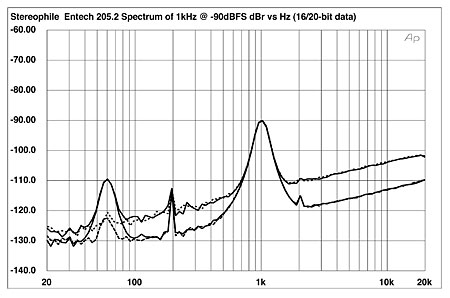
Fig.3 Entech 205.2, spectrum of dithered 1kHz tone at –90.31dBFS, with noise and spuriae: 16-bit data top, 20-bit data bottom (right channel dashed).
This low noise floor is also apparent in fig.4, which shows the spectrum of the cheaper 203.2's output while it decodes data representing digital silence. Again, the System One's output was set to both 16-bit and 20-bit data, and again, the 10dB improvement in dynamic range due to the greater word depth can be seen. Note the huge rise in noise above 30kHz. This was the same in both processors, and is due to the aggressive noise-shaping used by the Crystal delta-sigma DAC chip.
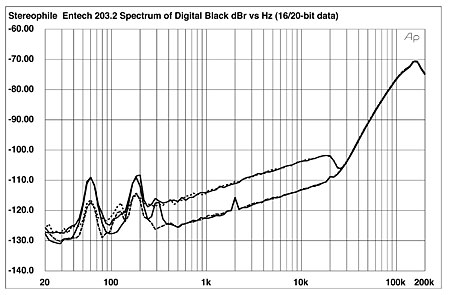
Fig.4 Entech 203.2, spectrum of digital silence with noise and spuriae: 16-bit data top, 20-bit data bottom. (1/3-octave analysis, right channel dashed.)
This DAC features excellent linearity. Fig.5 shows the linearity performance of the 203.2, which was actually slightly better than the 205.2. The level error is below 1dB to almost –110dBFS, which is superb. The low noise and excellent low-level linearity mean that the Entechs' reproduction of an undithered 16-bit, 1kHz tone at –90.31dBFS, which should be represented as three discrete voltage levels, was also superb—as shown by fig.6, the waveform reproduced by the 203.2. Increasing the word depth to 20 bits gave a reasonable facsimile of a sinewave (fig.7, 205.2).
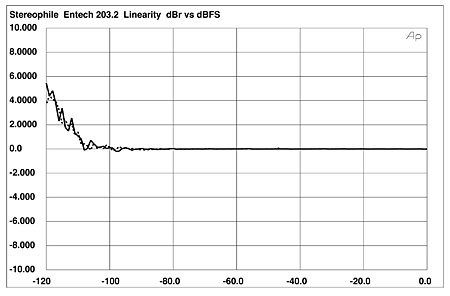
Fig.5 Entech 203.2, departure from linearity. (2dB/vertical div., right channel dashed.)
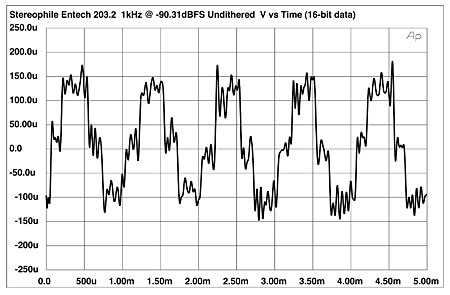
Fig.6 Entech 203.2, waveform of undithered 1kHz sinewave at –90.31dBFS (16-bit data).
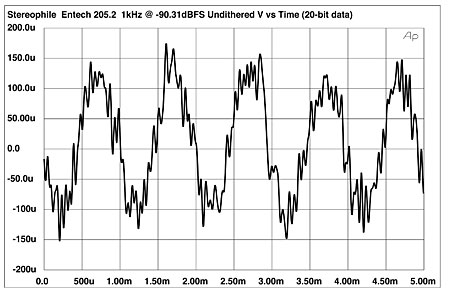
Fig.7 Entech 205.2, waveform of undithered 1kHz sinewave at –90.31dBFS (20-bit data).
Neither processor produced much in the way of harmonic distortion. Fig.8 shows the spectrum of the 205.2's output while it drove a 50Hz tone at full level into 100k ohms. The third harmonic can be seen at –96dB (0.0015%), with some higher harmonics visible at the same level; but these, I am sure, are subjectively innocuous.
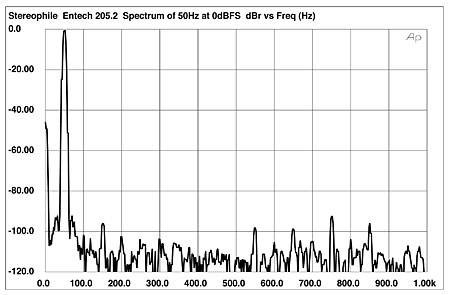
Fig.8 Entech 205.2, spectrum, DC–1kHz, 50Hz at 0dBFS (linear frequency scale, 20dB/vertical div.).
On high-frequency intermodulation, too, these inexpensive processors proved bombproof. Fig.9 is the output spectrum of the 205.2 while it reproduced 19kHz and 20kHz tones, each at –6dBFS. (The combined waveform just reaches full level.) The 1kHz difference product barely pokes its head above the –100dB level, which implies superb high-frequency linearity.
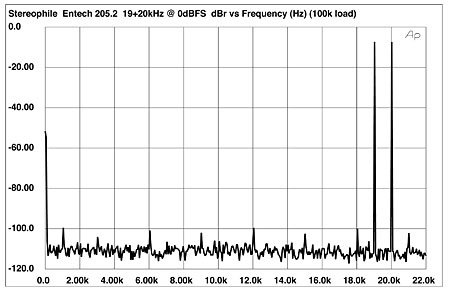
Fig.9 Entech 205.2, HF intermodulation spectrum, DC–22kHz, 19+20kHz at 0dBFS. (Linear frequency scale, 20dB/vertical div.)
Finally, I examined the Entechs' jitter performance with the Miller Audio Research analyzer, the Meridian 500 and PS Audio Lambda CD transports, and various datalinks. Both processors seemed quite sensitive to the datalink and transport used, as can be seen in fig.10. The foreground trace is for the lowest measured level of wordclock jitter I achieved, which was for the Entech 205.2 driven by the Meridian transport via a 1m length of anonymous TosLink optical datalink found lying around the test lab. The jitter level was just 148.5 picoseconds peak–peak—one of the lowest levels I have measured with this test setup. The main data-related jitter component is indicated by a red "4" in this graph; it has a level of just 69.5ps. There are some very low-frequency jitter components present, as well as a pair of 60Hz sidebands that are due to power-supply modulation, but these are all very low in level.
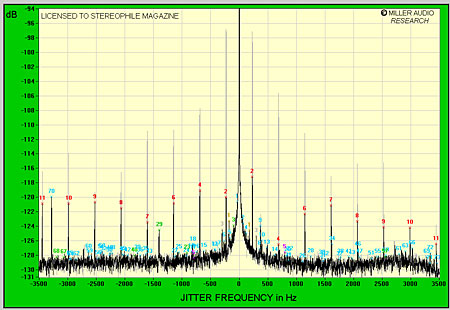
Fig.10 Entech 203.2, Meridian 500 CD transport via TosLink connection, high-resolution jitter spectrum of analog output signal. (11kHz at –6dBFS with LSB toggled at 229Hz.) Center frequency of trace, 11kHz; frequency range, ±3.5kHz. (Grayed-out trace is Meridian 500 via 75 ohm coaxial connection.)
The 203.2 behaved somewhat differently from the 205.2 in one respect: While its jitter level was almost as low with the TosLink connection (157.5ps), the lower-frequency data-related sidebands were higher in level than the higher-frequency ones to a greater extent. I have no idea what the subjective effect of this might be. Also present were more high-frequency components unrelated to the signal frequency than with the 205.2.
The grayed-out trace in fig.10 is the highest level of jitter I could produce from the 205.2, which was when I replaced the TosLink optical connection from the Meridian 500 with 1m of true 75 ohm coaxial cable (footnote 1). You can see that the data-related components, spaced at 229Hz intervals, have all risen dramatically. The fundamental sidebands, for example, have gone from 69.5ps to 818ps, with the overall level now 908ps. Note also the noise "skirts" either side of the central peak in this graph. This seems to be typical of Crystal's delta-sigma DACs; it has been conjectured that such behavior exaggerates the size of individual images within the soundstage.
To sum up, I find astonishing the level of measured performance audiophiles can now buy for less than $500, as typified by these Entech Number Crunchers.—John Atkinson
Footnote 1: A TosLink optical link has a lower bandwidth than an electrical connection, thus inherently introducing jitter that is correlated with the analog signal encoded within the bits. However, an electrical connection has to have the transmitter and receiver resistances and the characteristic impedance of the cable carefully matched if word-clock jitter is to remain low.—John Atkinson
- Log in or register to post comments




































